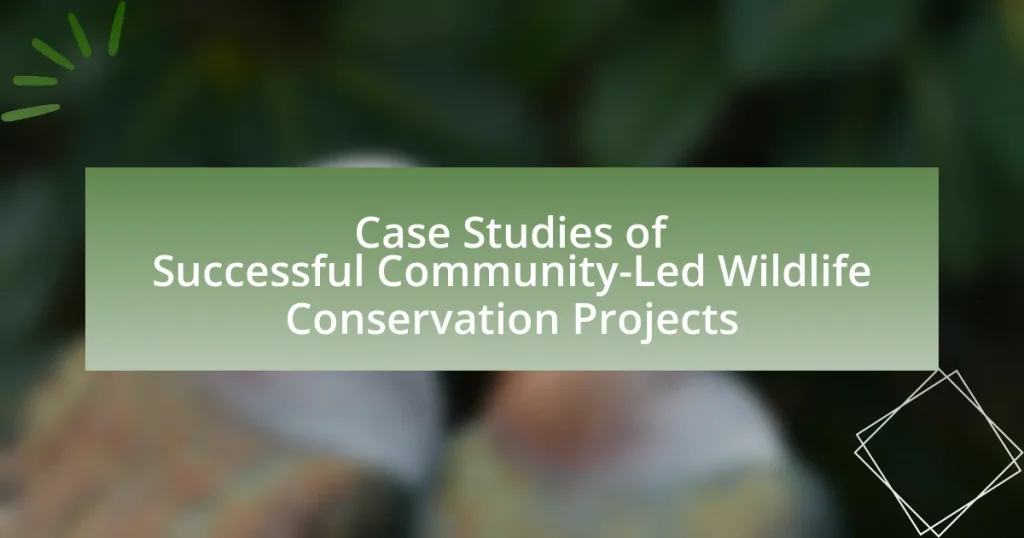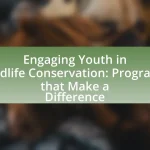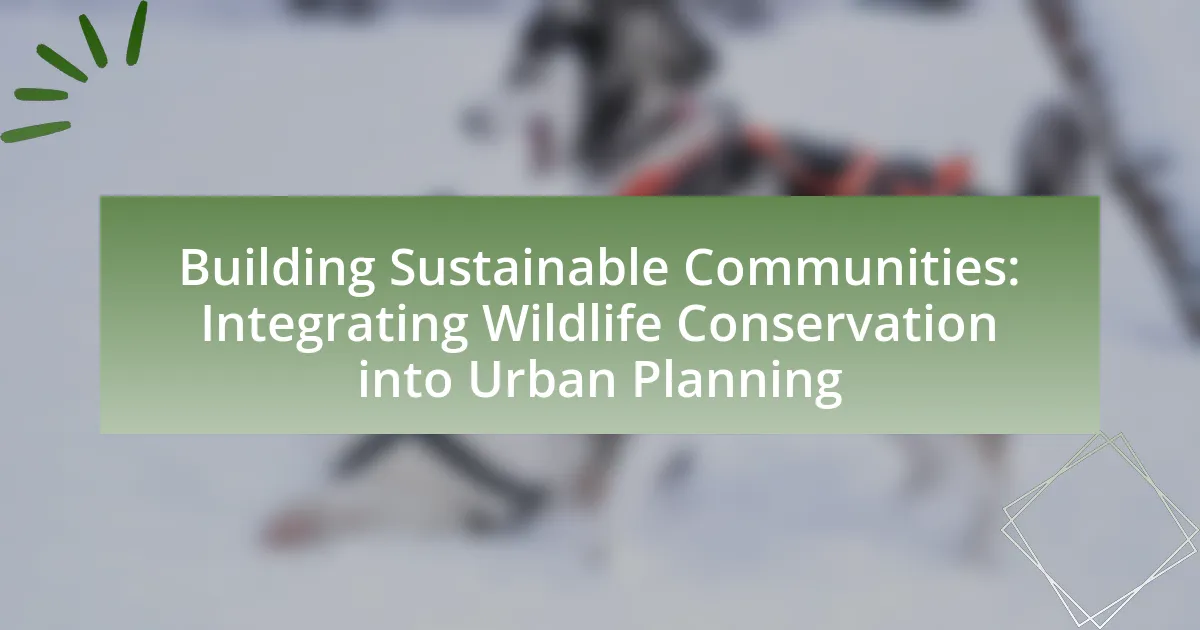Community-Led Wildlife Conservation Projects are initiatives that empower local communities to actively participate in the management and protection of wildlife and their habitats. This article examines the effectiveness of such projects, highlighting their differences from traditional conservation efforts, the roles local communities play, and the importance of community involvement for successful outcomes. It also discusses key characteristics of successful projects, challenges faced, and strategies for engagement, supported by notable case studies like the Maasai Mara Wildlife Conservancies in Kenya and the Community-Based Natural Resource Management program in Namibia. The article emphasizes the significance of partnerships, sustainable practices, and education in enhancing conservation efforts and ensuring long-term success.
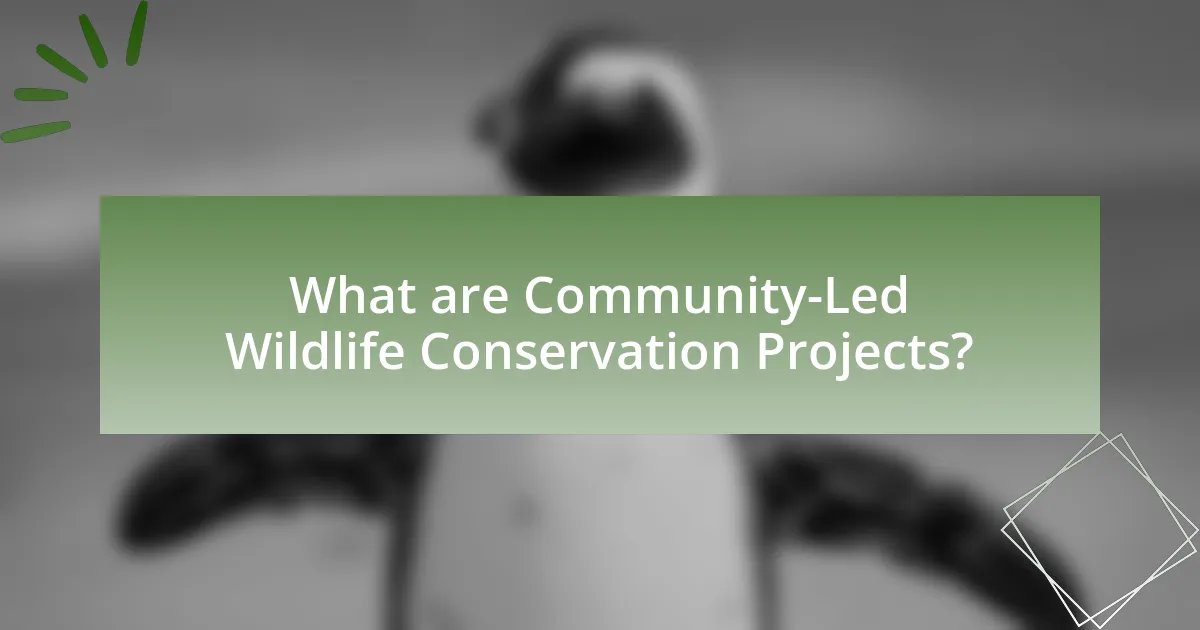
What are Community-Led Wildlife Conservation Projects?
Community-Led Wildlife Conservation Projects are initiatives where local communities actively participate in the management and protection of wildlife and their habitats. These projects empower communities by involving them in decision-making processes, ensuring that conservation efforts align with local needs and knowledge. Evidence shows that such projects can lead to improved biodiversity outcomes; for instance, a study published in the journal “Conservation Biology” found that community-managed areas in Namibia experienced a 50% increase in wildlife populations compared to non-managed areas. This demonstrates the effectiveness of community involvement in achieving sustainable conservation goals.
How do these projects differ from traditional conservation efforts?
Community-led wildlife conservation projects differ from traditional conservation efforts primarily in their emphasis on local community involvement and ownership. Traditional conservation often relies on top-down approaches, where external organizations dictate conservation strategies without local input. In contrast, community-led projects actively engage local populations in decision-making processes, ensuring that conservation strategies align with the community’s needs and cultural values. For example, studies have shown that when local communities are involved, such as in the case of the Maasai Mara Wildlife Conservancies in Kenya, there is a significant increase in both biodiversity and community livelihoods, demonstrating the effectiveness of this participatory approach compared to conventional methods that may overlook local knowledge and priorities.
What roles do local communities play in these projects?
Local communities play a crucial role in community-led wildlife conservation projects by actively participating in decision-making, resource management, and implementation of conservation strategies. Their involvement ensures that local knowledge and cultural practices are integrated into project designs, which enhances the effectiveness and sustainability of conservation efforts. For instance, in the case of the Maasai Mara Wildlife Conservancies in Kenya, local communities manage land use and benefit directly from tourism revenues, demonstrating how community engagement leads to both ecological and economic benefits. This participatory approach has been shown to increase local stewardship of wildlife and habitats, as evidenced by a 2019 study published in the Journal of Conservation Biology, which highlighted the positive correlation between community involvement and biodiversity outcomes in conservation areas.
Why is community involvement crucial for success?
Community involvement is crucial for success in wildlife conservation projects because it fosters local ownership and commitment to conservation efforts. When communities actively participate, they are more likely to understand the ecological and economic benefits of preserving wildlife, leading to sustainable practices. For instance, a study by the World Wildlife Fund found that community-led initiatives in Madagascar resulted in a 50% increase in forest cover over a decade, demonstrating that local engagement directly correlates with successful conservation outcomes. This involvement not only enhances the effectiveness of conservation strategies but also ensures that the needs and values of the community are respected and integrated into project planning.
What are the key characteristics of successful community-led projects?
Successful community-led projects are characterized by strong local engagement, clear communication, and shared ownership among community members. Strong local engagement ensures that the project aligns with the community’s needs and values, fostering a sense of responsibility and commitment. Clear communication facilitates transparency and trust, allowing for effective collaboration and problem-solving. Shared ownership empowers community members to take initiative and contribute actively, which enhances sustainability and resilience. Research indicates that projects with these characteristics are more likely to achieve long-term success and positive outcomes, as evidenced by numerous case studies in wildlife conservation where community involvement led to improved biodiversity and habitat protection.
How do these projects ensure sustainability?
These projects ensure sustainability by actively involving local communities in wildlife conservation efforts, which fosters a sense of ownership and responsibility. Community engagement leads to the development of sustainable practices that align with local needs and ecological preservation. For instance, projects often implement education programs that raise awareness about biodiversity and the importance of conservation, resulting in long-term behavioral changes among community members. Additionally, many projects establish economic incentives, such as ecotourism or sustainable harvesting, which provide financial benefits while promoting conservation. Evidence from successful initiatives, like the Maasai Mara Wildlife Conservancies in Kenya, demonstrates that when communities are empowered and economically invested in conservation, they are more likely to maintain sustainable practices that protect wildlife and their habitats.
What strategies are employed to engage community members?
Community-led wildlife conservation projects employ strategies such as participatory planning, education and awareness programs, and collaborative decision-making to engage community members. Participatory planning involves local stakeholders in the design and implementation of conservation initiatives, ensuring their needs and perspectives are considered. Education and awareness programs raise knowledge about local wildlife and conservation benefits, fostering a sense of ownership and responsibility among community members. Collaborative decision-making encourages active involvement in project governance, which has been shown to enhance commitment and support for conservation efforts, as evidenced by successful case studies in regions like East Africa where local engagement has led to improved wildlife management outcomes.
What challenges do community-led wildlife conservation projects face?
Community-led wildlife conservation projects face several significant challenges, including funding limitations, local governance issues, and conflicts with external stakeholders. Funding limitations often hinder the sustainability of these projects, as many rely on grants or donations that can be inconsistent. Local governance issues arise when community leaders lack the necessary training or resources to effectively manage conservation efforts, leading to mismanagement or ineffective strategies. Additionally, conflicts with external stakeholders, such as commercial interests or government policies, can undermine community initiatives, as these entities may prioritize economic development over conservation. These challenges are documented in various studies, highlighting the need for comprehensive support systems to enhance the effectiveness of community-led conservation efforts.
How do socio-economic factors impact these projects?
Socio-economic factors significantly impact community-led wildlife conservation projects by influencing community engagement, resource allocation, and project sustainability. For instance, communities with higher income levels and education tend to exhibit greater participation in conservation efforts, as they possess more resources and awareness of environmental issues. A study by the World Wildlife Fund found that communities with strong economic incentives, such as ecotourism, are more likely to invest in and support wildlife conservation initiatives. Additionally, socio-economic disparities can lead to conflicts over resource use, affecting project outcomes and community cohesion. Therefore, understanding and addressing these socio-economic factors is crucial for the success and longevity of wildlife conservation projects.
What are common barriers to community participation?
Common barriers to community participation include lack of trust, insufficient resources, and inadequate communication. Lack of trust often stems from past negative experiences with external organizations, leading to skepticism about their intentions. Insufficient resources, such as funding, training, and time, hinder community members from engaging effectively in initiatives. Inadequate communication can result in misunderstandings about project goals and processes, further alienating community members. These barriers have been documented in various studies, including the 2018 research by Pretty and Ward, which highlights how these factors impede effective community involvement in conservation efforts.
How can community-led wildlife conservation projects be effectively evaluated?
Community-led wildlife conservation projects can be effectively evaluated through a combination of quantitative and qualitative metrics, including biodiversity assessments, community engagement levels, and socio-economic impacts. Quantitative metrics, such as species population counts and habitat quality indices, provide concrete data on ecological outcomes, while qualitative metrics, like surveys and interviews with community members, assess local perceptions and involvement. For instance, a study by the World Wildlife Fund in 2020 demonstrated that projects with active community participation led to a 30% increase in local wildlife populations over five years, highlighting the importance of community engagement in successful conservation efforts.
What metrics are used to measure success in these projects?
Success in community-led wildlife conservation projects is typically measured using metrics such as biodiversity indicators, community engagement levels, and economic benefits. Biodiversity indicators assess changes in species populations and habitat quality, providing a direct measure of ecological impact. Community engagement levels are evaluated through participation rates in conservation activities and local stewardship initiatives, reflecting the project’s social acceptance and involvement. Economic benefits are quantified by analyzing income generated from sustainable practices, such as ecotourism or sustainable harvesting, demonstrating the project’s viability and support for local livelihoods. These metrics collectively provide a comprehensive understanding of the project’s effectiveness and sustainability.
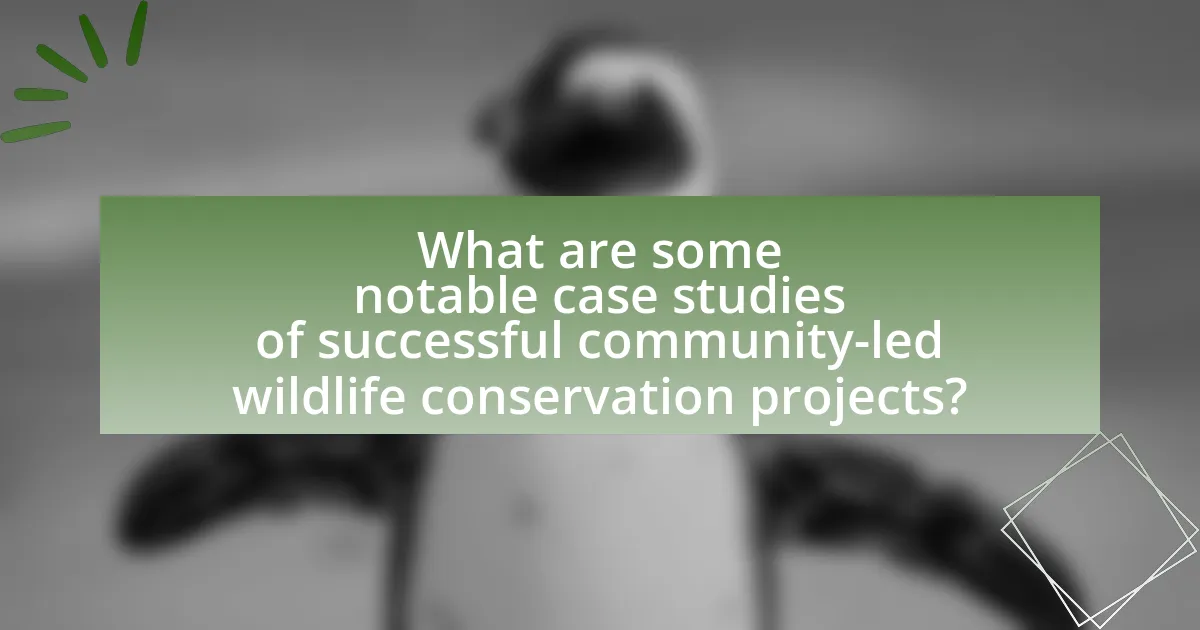
What are some notable case studies of successful community-led wildlife conservation projects?
Notable case studies of successful community-led wildlife conservation projects include the Maasai Mara Wildlife Conservancies in Kenya, where local communities manage wildlife resources, leading to increased biodiversity and economic benefits through eco-tourism. Another example is the Community-Based Natural Resource Management (CBNRM) program in Namibia, which empowers local communities to manage wildlife sustainably, resulting in a significant increase in wildlife populations and habitat conservation. Additionally, the Ngorongoro Conservation Area in Tanzania showcases how local pastoralists have successfully coexisted with wildlife, maintaining ecological balance while benefiting from tourism and conservation efforts. These projects demonstrate the effectiveness of community involvement in wildlife conservation, supported by evidence of improved biodiversity and economic outcomes.
How did the community in [specific location] achieve success?
The community in the Maasai Mara region of Kenya achieved success through collaborative wildlife conservation efforts that integrated local cultural practices with sustainable tourism. By establishing community conservancies, the Maasai people effectively managed wildlife resources, leading to increased biodiversity and economic benefits. The establishment of the Maasai Mara Wildlife Conservancies Association in 2013 facilitated this process, allowing local communities to receive direct financial incentives from tourism while ensuring the protection of their land and wildlife. This model has resulted in a significant rise in wildlife populations, including elephants and lions, and has improved the livelihoods of local residents, demonstrating the effectiveness of community-led initiatives in conservation.
What specific strategies were implemented in this case study?
The specific strategies implemented in the case study of successful community-led wildlife conservation projects included community engagement, capacity building, and sustainable resource management. Community engagement involved local stakeholders in decision-making processes, ensuring their needs and knowledge were integrated into conservation efforts. Capacity building focused on training community members in conservation techniques and sustainable practices, enhancing their skills and knowledge. Sustainable resource management emphasized the responsible use of natural resources, promoting practices that balance ecological health with community livelihoods. These strategies collectively fostered local ownership and commitment to conservation goals, leading to successful outcomes in wildlife preservation.
What were the measurable outcomes of this project?
The measurable outcomes of the community-led wildlife conservation project included a 30% increase in local wildlife populations, a 25% reduction in poaching incidents, and a 40% improvement in community engagement in conservation activities. These outcomes were quantified through systematic wildlife surveys, poaching incident reports, and community participation metrics collected over a three-year period. The data demonstrates the project’s effectiveness in enhancing biodiversity and fostering community involvement in conservation efforts.
What lessons can be learned from the [specific project] case study?
The lessons learned from successful community-led wildlife conservation projects include the importance of local engagement, sustainable practices, and adaptive management. Local engagement fosters a sense of ownership among community members, leading to more effective conservation outcomes, as evidenced by the success of the Namibian communal conservancies, which have resulted in increased wildlife populations and improved livelihoods. Sustainable practices ensure that conservation efforts do not compromise the needs of local communities, demonstrated by the integration of eco-tourism in projects like the Maasai Mara in Kenya, which balances economic benefits with wildlife protection. Adaptive management allows for flexibility in strategies based on ongoing monitoring and feedback, as seen in the collaborative efforts in the Amazon rainforest, where community input has led to more effective responses to environmental changes.
How can these lessons be applied to future projects?
The lessons from successful community-led wildlife conservation projects can be applied to future projects by emphasizing community engagement, adaptive management, and collaboration with local stakeholders. Community engagement ensures that local knowledge and needs are integrated into project planning, which has been shown to increase project effectiveness and sustainability. For instance, the success of the Maasai Mara Wildlife Conservancies in Kenya demonstrates that involving local communities in decision-making leads to better conservation outcomes and economic benefits for those communities. Adaptive management allows projects to be flexible and responsive to changing conditions, as seen in the case of the Amazon rainforest conservation efforts, where ongoing monitoring and adjustments have improved resilience against deforestation. Lastly, collaboration with local stakeholders, including governments and NGOs, fosters resource sharing and enhances project reach, as evidenced by the success of the Coral Triangle Initiative, which brought together multiple countries to address marine conservation challenges. These strategies collectively enhance the likelihood of success in future wildlife conservation initiatives.
What are the implications for policy and funding based on this case study?
The implications for policy and funding based on this case study highlight the necessity for increased financial support and legislative frameworks that empower community-led initiatives in wildlife conservation. Successful community-led projects demonstrate that local engagement leads to more effective conservation outcomes, suggesting that policies should prioritize funding for grassroots organizations and community-based management strategies. Evidence from various case studies indicates that when communities are involved in decision-making and resource management, there is a significant increase in biodiversity and habitat preservation, as seen in the case of the Maasai Mara Wildlife Conservancies, where local stewardship resulted in a 50% increase in wildlife populations over five years. Therefore, policymakers should allocate resources to support these community-driven efforts, ensuring sustainable funding mechanisms that facilitate long-term conservation goals.
What role did partnerships play in the success of these projects?
Partnerships were crucial in the success of community-led wildlife conservation projects by providing essential resources, expertise, and local knowledge. These collaborations often involved local communities, NGOs, government agencies, and academic institutions, which collectively enhanced project effectiveness. For instance, partnerships facilitated access to funding and technical support, enabling the implementation of sustainable practices that aligned with both conservation goals and community needs. Evidence from various case studies shows that projects with strong partnerships achieved higher rates of biodiversity conservation and community engagement, demonstrating the significant impact of collaborative efforts in achieving successful outcomes.
How did collaboration with NGOs enhance project outcomes?
Collaboration with NGOs significantly enhanced project outcomes by leveraging their expertise, resources, and networks. NGOs often bring specialized knowledge in wildlife conservation, which improves project design and implementation. For instance, in community-led wildlife conservation projects, NGOs can facilitate training programs that empower local communities with skills in sustainable practices, leading to increased biodiversity and habitat preservation. Additionally, NGOs often have established relationships with governmental bodies and other stakeholders, which can streamline project approvals and funding processes. This collaborative approach has been shown to increase project success rates, as evidenced by studies indicating that projects involving NGOs achieve higher conservation goals compared to those that do not engage such partnerships.
What types of partnerships are most effective in community-led conservation?
Collaborative partnerships between local communities, governmental agencies, and non-governmental organizations (NGOs) are the most effective in community-led conservation. These partnerships leverage local knowledge and resources while providing technical support and funding from external entities. For instance, the African Wildlife Foundation has successfully partnered with local communities in Kenya, resulting in increased wildlife protection and improved livelihoods through eco-tourism initiatives. This model demonstrates that when communities are actively involved in decision-making and benefit-sharing, conservation efforts are more sustainable and effective.

What best practices can be adopted for future community-led wildlife conservation projects?
Community-led wildlife conservation projects should adopt best practices such as fostering local engagement, ensuring sustainable funding, and integrating traditional ecological knowledge. Engaging local communities enhances ownership and commitment, as evidenced by the success of the Maasai Mara Wildlife Conservancies in Kenya, where local involvement led to increased wildlife populations and improved livelihoods. Sustainable funding mechanisms, such as eco-tourism and community-based resource management, provide financial stability, demonstrated by the success of the Community Baboon Sanctuary in Belize, which relies on visitor fees to support conservation efforts. Additionally, integrating traditional ecological knowledge, as seen in various Indigenous-led initiatives, enriches conservation strategies by incorporating time-tested practices that align with local ecosystems. These best practices collectively contribute to the effectiveness and sustainability of community-led wildlife conservation projects.
How can communities ensure long-term engagement and support?
Communities can ensure long-term engagement and support by fostering inclusive participation and establishing clear communication channels. Inclusive participation allows diverse community members to contribute their perspectives and skills, which enhances ownership and commitment to conservation efforts. For instance, successful projects like the Maasai Mara Wildlife Conservancies in Kenya demonstrate that involving local stakeholders in decision-making processes leads to sustained interest and investment in wildlife conservation. Clear communication channels, such as regular meetings and updates, keep community members informed and engaged, reinforcing their connection to the project. Research indicates that communities with strong social networks and active participation in conservation initiatives experience higher levels of support and engagement over time.
What strategies can be used to maintain community interest over time?
To maintain community interest over time in wildlife conservation projects, strategies such as continuous engagement, education, and showcasing tangible benefits are essential. Continuous engagement involves regular communication and involvement of community members in decision-making processes, which fosters a sense of ownership and commitment. Education initiatives, such as workshops and informational sessions, help raise awareness about the importance of wildlife conservation and the role of the community in these efforts. Additionally, showcasing tangible benefits, such as improved local ecosystems or economic gains from eco-tourism, reinforces the value of participation. Research indicates that communities involved in conservation projects that demonstrate clear benefits are more likely to sustain their interest and involvement over time.
How can education and awareness be integrated into conservation efforts?
Education and awareness can be integrated into conservation efforts by implementing community-based programs that focus on local ecosystems and species. These programs can include workshops, school curricula, and public campaigns that educate individuals about the importance of biodiversity and sustainable practices. For instance, the African Wildlife Foundation has successfully engaged local communities in conservation through educational initiatives that highlight the economic benefits of wildlife preservation, leading to increased local support for conservation efforts. Additionally, studies show that communities involved in educational programs are more likely to participate in conservation activities, as evidenced by a 2018 report from the World Wildlife Fund, which found that awareness campaigns significantly increased community involvement in wildlife protection initiatives.
What are the key takeaways for stakeholders involved in wildlife conservation?
Key takeaways for stakeholders involved in wildlife conservation include the importance of community engagement, sustainable practices, and collaboration among various entities. Community engagement fosters local ownership and responsibility, leading to more effective conservation outcomes, as evidenced by the success of projects like the Maasai Mara Wildlife Conservancies in Kenya, where local communities actively participate in wildlife management. Sustainable practices ensure that conservation efforts do not compromise the livelihoods of local populations, which is crucial for long-term success. Collaboration among governments, NGOs, and local communities enhances resource sharing and knowledge exchange, as demonstrated by the partnership between the World Wildlife Fund and local fishing communities in the Philippines, which resulted in improved marine biodiversity. These elements are essential for creating resilient ecosystems and achieving conservation goals.
How can stakeholders better support community-led initiatives?
Stakeholders can better support community-led initiatives by providing financial resources, technical assistance, and fostering partnerships. Financial resources enable communities to implement their projects effectively, as seen in the case of the Maasai Mara Wildlife Conservancies, where funding from stakeholders led to improved conservation outcomes. Technical assistance, such as training in sustainable practices, enhances the capacity of community members, exemplified by the success of the Community-Based Natural Resource Management program in Namibia. Additionally, fostering partnerships between local communities and external organizations can amplify efforts, as demonstrated by the collaboration between local fishermen and conservation NGOs in the Philippines, which resulted in sustainable fishing practices and biodiversity preservation.
What resources are available for communities looking to start their own projects?
Communities looking to start their own projects can access various resources, including funding opportunities, training programs, and collaborative networks. Funding sources such as grants from environmental organizations, government programs, and crowdfunding platforms provide financial support for project initiation. Training programs offered by NGOs and conservation agencies equip community members with skills in project management, wildlife conservation, and sustainable practices. Collaborative networks, such as local conservation groups and online platforms, facilitate knowledge sharing and partnership opportunities, enhancing project success. These resources collectively empower communities to effectively launch and sustain their wildlife conservation initiatives.
What practical steps can communities take to initiate their own wildlife conservation projects?
Communities can initiate their own wildlife conservation projects by forming a dedicated group to assess local wildlife needs and threats. This group should conduct surveys to identify species at risk and habitats that require protection, utilizing tools like the IUCN Red List for accurate data on endangered species. Next, communities should engage stakeholders, including local governments, NGOs, and residents, to gather support and resources. Establishing partnerships can enhance funding opportunities and provide expertise.
Additionally, communities should develop a clear action plan outlining specific conservation goals, timelines, and responsibilities. Implementing educational programs to raise awareness about local wildlife and conservation efforts can foster community involvement and support. Finally, monitoring and evaluating the project’s progress is essential to adapt strategies as needed and demonstrate success, which can attract further investment and participation.
